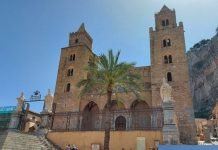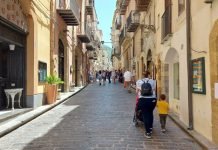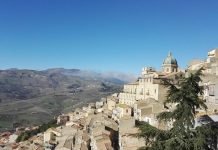If you are wondering what to see in Palermo during your next vacation in Sicily, know that the number of places and monuments not to be missed is so great that it makes it difficult to choose.
Palermo is in fact rich in important artistic and monumental testimonies and green spaces that make it one of the most important Italian tourist destinations.
If you have decided to visit Palermo during your holidays in Sicily, you will find the list of its ten must-see places that we have created for you really useful.
In particular we will talk about:
- Palazzo dei Normanni
- Palermo Cathedral
- Palazzo Chiaramonte-Steri
- Mount Pellegrino and Sanctuary of Santa Rosalia
- Mondello Beach
- Church of San Cataldo, Piazza Pretoria and Quattro Canti
- Piazza Pretoria
- The Capuchin Catacombs
- The Teatro Massimo
- The Politeama Theater
Let’s see in detail why you should absolutely include these places in your itinerary, are you ready?
Indice
Palazzo dei Normanni
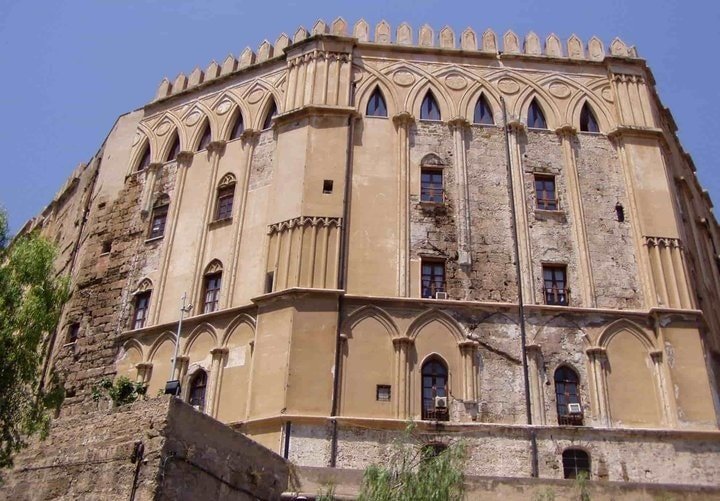
The Palazzo dei Normanni (also know as “Norman Palace” or “Royal Palace“), in Piazza Indipendenza 1 in Palermo, is one of the most famous and visited monuments in Palermo for its immense historical importance.
The palace was built in the 9th century under Arab domination in what was most likely a Punic and Roman fortress, and was later expanded by the Normans who made it a royal residence and an important institutional seat.
To the original construction, the Normans decided to add manufacturing plants and new buildings, but following the decline of the Swabian dynasty in the 13th century, the palace began to lose importance and fell into a state of neglect.
Only in 1921 did work begin to find the ancient factories now buried and instead all the other rooms of incredible beauty were found, including the treasure room.
Four jars were discovered, walled up in the floor, capable of holding millions of gold coins.
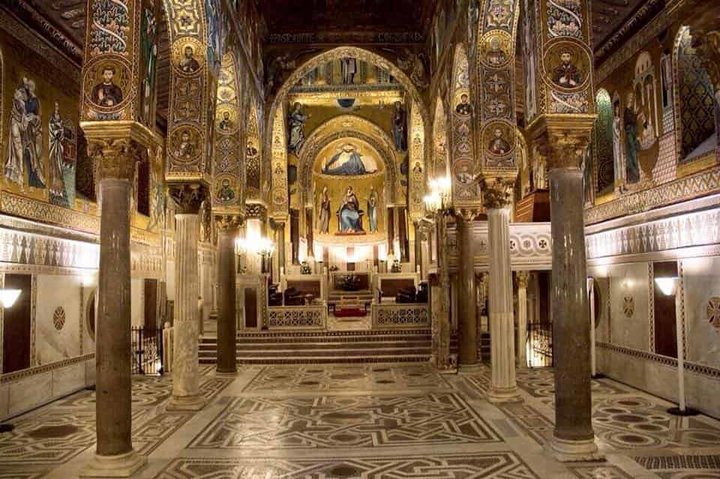
On the first floor of the Palazzo dei Normanni is the Palatine Chapel, a splendid testimony to the Norman period.
The magnificence that fills the eyes of the visitor when he enters it is difficult to describe in words: the three naves are divided by massive granite columns that support a series of pointed arches.
The sanctuary, which is raised above the rest of the environment, has a mosaic floor and a hemispherical dome above it. The entire chapel is a riot of inscriptions, paintings and mosaics that shine thanks to the golden hues and the Arab, Roman and Byzantine elements blend into a harmony of forms and colors probably unique in the world.
At the beginning of the main nave there is the royal throne, and on the right there is a wonderful ambo supported by decorated columns. Particularly suggestive is the adjacent Chamber of Parliament, built in 1560 and today used for the sittings of the Sicilian Regional Assembly.
The royal apartments are composed of the Sala dei Viceré, enriched with portraits of the viceroys of Sicily, the beautiful dining room and finally the Sala di Re Ruggero, embellished with mosaics depicting everyday hunting scenes and which cover the two walls to the ceiling.
Finally, on the top floor there is the Astronomical Observatory, dating back to 1786 (Bourbon period), which houses a very interesting museum in which there are ancient astronomical instruments: including a sextant, achromatic telescopes and some barometers.
Palermo Cathedral

The Palermo Cathedral is probably one of the most famous and important monuments in Italy. It was built in 1184 on the site of a basilica, but it was converted into a mosque by the Arabs (it was able to accommodate up to 7,000 faithful at the same time) until with the advent of the Normans it was returned to Christian worship.
Following the radical restructuring of the late 18th century, the side naves and the famous dome were added. The main facade has two tall towers and arched windows with a small column in the center (the so-called “bifore”) and splendid arcades.
In the aedicle placed just above the main portal it is possible to admire a Madonna of the 15th century, while the ancient wooden doors have been replaced by modern bronze doors depicting various scenes from the New and Old Testaments.
On the front facing Corso Vittorio Emanuele you can admire three ogival arches in Catalan Gothic style, and on the leftmost one you can read a verse from the Koran, probably engraved during the period of conversion to a mosque.
The interior was also renovated in the late 18th century and has three different naves separated by granite pillars and columns. Here you can admire works of art of great value: among these the remains of a Gaginesque tribune and statues by Antonello Gagini.
In the initial part of the right nave you can find royal and majestic tombs: among these the sarcophagus of Constance of Aragon, the tomb of Frederick II (husband of Constance of Aragon), that of Peter II of Aragon, the tomb of Roger II and the sarcophagus which houses the remains of William Duke of Athens.
To the right of the presbytery you can find the chapel of St. Rosalia, patron saint of the city, which houses a silver urn containing the relics of the “Santuzza” (as the Palermitans call her). In the presbytery you can admire an episcopal throne and various mosaics, while a wonderful wooden crucifix from the 14th century can be admired above the altar.
Inside the Sacrestia dei Canonici you can admire the Treasury, which houses sacred vestments, Byzantine enamels, medieval jewelry and objects of great value found inside the royal tombs mentioned above.
For some years now, it has also been possible, by appointment, to book a guided tour of the cathedral roofs thanks to some very interesting evening openings.
It is the perfect opportunity to observe Palermo from an unusual perspective and admire the splendor of its cathedral even more closely.
Palazzo Chiaramonte-Steri

Palazzo Chiaramonte-Steri, also known simply as “Palazzo Steri“, was built in the early 16th century and was the residence of Manfredi Chiaramonte, Count of the Modica fief and representative of the most powerful and important family in 14th century Sicily.
The palace has a square plan with a large atrium in the center, and for almost 200 years it was the seat of the Inquisition tribunal (between 1660 and 1782).
Precisely because of the historical importance of this palace, inevitably linked to that of the Inquisition, there were heated controversies during its restoration in 1946: the architect Giuseppe Spartisano in fact decided to resign from the assignment entrusted to him due to disagreements with other colleagues, who decided to cancel important signs of the history of Palazzo Steri such as the cages that were present inside and the platform for the condemned.
During a more recent restoration that involved the facade, grooves were found marked by the large cages that were hung to display the severed heads of those who dared to rebel against King Charles V.
Inside the rooms formerly used as prisons, and now open to the public, it is still possible to see drawings, graffiti and inscriptions on the walls made by those who were once imprisoned there. Some inscriptions are in Italian, others in Latin and still others in dialect.
Wax from candles or ash was used to write on the walls, and the inscriptions found tell of scenes of daily life in the prison, poems, dreams, hopes of one day being able to embrace loved ones again and ironic phrases.
In one particular room, an accurate map of Sicily was drawn on the wall, which also bears the names of many cities and villages that have been marked with great precision: it is certainly the work of a great traveler, considering that at the time there were no satellite images.
Where the bathrooms were instead, an inscription on the wall invites you to move a specific stone (placed right under the inscription) to be able to communicate with the prisoners who were exactly on the lower floor, in the corresponding room.
Finally, a little gem: for some years now it has been possible to visit Palazzo Steri at night, on the occasion of an event called “La notte delle streghe” (The Witches’ Night) organized by a local association.
It is a very special guided tour, as there are witches waiting for visitors in the dim light of the palace and leading them on a tour of the cells illuminated by the light of candles only. The ticket price is €5.
Mount Pellegrino and Sanctuary of St. Rosalia

Mount Pellegrino, described by Goethe as “The most beautiful promontory in the world“, is a very special mountain relief 606 meters high that is literally located within Palermo.
Here the peregrine falcon nests, but it is also possible to meet rabbits, wild boars and goats. On its sides you can see 134 caves of great prehistoric importance, including the caves of the Addaura, inside which you can admire men and animals engraved on the rock, dating back to the Paleolithic period.
From the top of the summit, which can be reached by car or on foot, you can enjoy a wonderful panorama, or rather three: from the belvedere overlooking the north-east side you can admire Ustica and the Aeolian Islands; the west side offers a wonderful view from above of the beautiful Mondello beach, while from the east side you can admire the city in all its splendor (this last view is particularly evocative and romantic at night).
The name of Monte Pellegrino is closely linked to that of Santa Rosalia, the patron saint of Palermo. The sanctuary (located right at the top) dedicated to her dates back to 1625 and includes a convent with one side literally leaning against the rock and a cave that has now become a chapel.
The saint (or “Santuzza“, as the people of Palermo call her) was born in 1130 and retired in penance on Mount Pellegrino many years before her death, which occurred in 1166.
Legend has it that to a hunter, who arrived near the place where the sanctuary now stands, the face of Rosalia appeared in the rock, leading him towards the cave and inviting him to tell the Archbishop to carry in procession through the city the bones (hers) recently found inside the cave itself, because this would have put an end to the wave of plague that in that period caused thousands of victims in the city.
On June 9, 1625, the procession took place with a great following of people, and at the passage of the bones the sick miraculously healed from the plague with amazement by everyone.
The King’s servants recorded in the municipal registers the personal data of all those who healed at that moment, without any scientific explanation.
Mondello Beach

Located along the arc of the beautiful bay between Monte Gallo and Monte Pellegrino, Mondello Beach is the quintessential seaside resort of Palermo, one of the most famous in Sicily.
Mondello is much more than just a beach; it is an ancient seaside village. During the Arab domination, Mondello was born as a fishing village, a small village that lived on what the sea had to offer (the part that we know today as the beach was however a swamp at that time) and boasted a small port and a tuna fishery of which only a tower remains (it is located in the main square of Mondello).
The marshy land was reclaimed at the end of the 19th century and gradually became a place capable of attracting the Palermo elite of the time. Mondello’s charm still exerts a strong influence on the people of Palermo, who consider this beach to be a bit like their own home.
After a day at the beach, the people of Palermo enjoy strolling to the main square of Mondello, which is called “Piazza Mondello“, and indulging in a good ice cream or a plate of pasta with fish served by the many bars and restaurants in the area.
Others prefer to enjoy a delicious pane con le panelle (a traditional Sicilian chickpea fritter sandwich) served by the fryers in the square, and eat it hot while watching the sea from the pier.
Church of San Cataldo, Piazza Pretoria and Quattro Canti
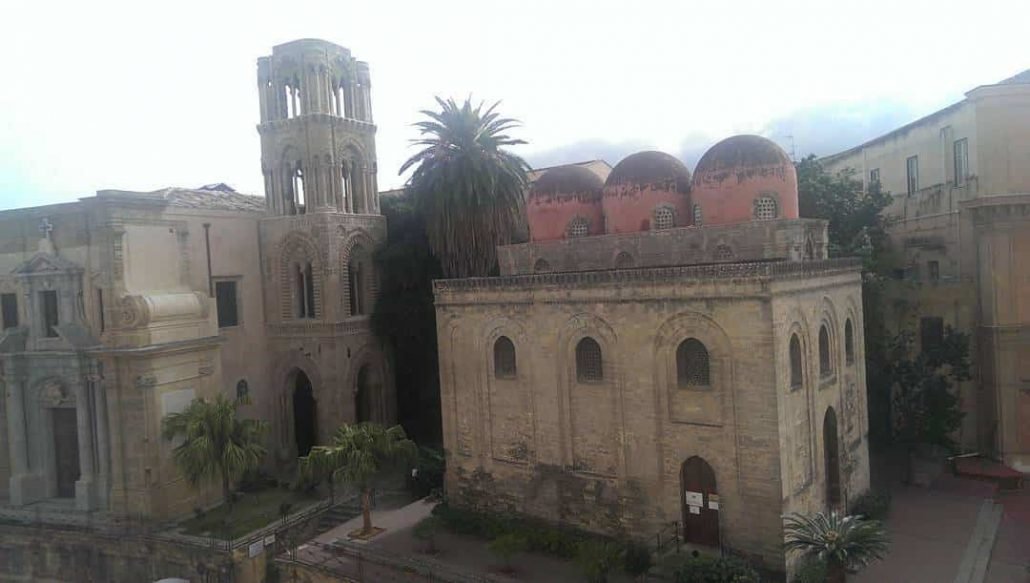
In the evocative Piazza Bellini stands the beautiful church of San Cataldo, built in the Norman period, which has typically square architectural forms and three red domes on the roof.
On each facade there are three single-lancet windows closed by a metal grid, which together with the three domes, give the entire building a particularly Arab appearance.
The interior has three naves separated by six columns with splendid capitals and a mosaic floor, which is original even if it has been restored over time. The altar is also original and has some engravings depicting a cross and a lamb.
The church of San Cataldo is just a few steps away from one of the most beautiful and fascinating squares in Palermo, Piazza Pretoria.
Piazza Pretoria: A Palermo’s Must-See Square
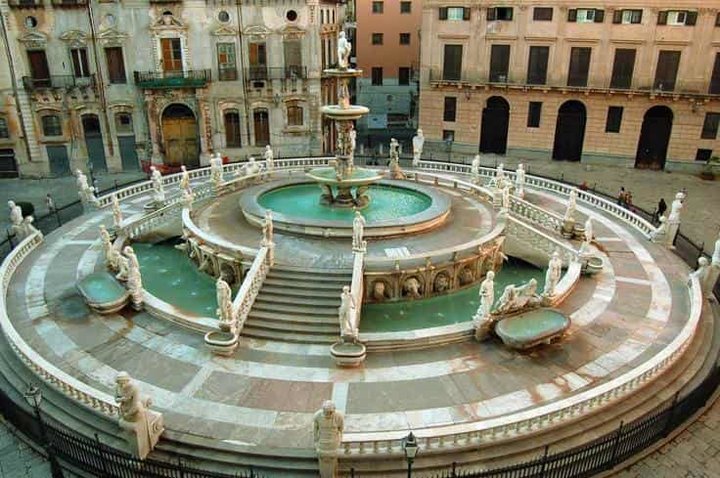
Surrounded by buildings of great historical and architectural value, Piazza Pretoria is one of the most important squares in Palermo. Almost all of the space here is occupied by the magnificent Fontana Pretoria, created in 1554 by the Florentine artist Francesco Camilliani.
The fountain is entirely surrounded by an elegant black railing, which has recently been decided to be opened to allow visitors to access and view the statues up close.
The statues themselves capture the attention of visitors more than anything else: they represent various deities and are depicted nude in most cases, which is why the entire square is called “Piazza della Vergogna” (Square of Shame) by the people of Palermo.
Right in front of the fountain is the Palermo City Hall, called Palazzo delle Aquile, which houses a statue of Santa Rosalia, the city’s patron saint, in a cavity at the top of the building.

The adjacent Via Maqueda was created towards the end of the 16th century, following the pressure that the Palermo nobility of the time exerted on the Viceroy, demanding new spaces in which to build their palaces.
This elegant and enchanting street intersects perpendicularly with the Càssaro (today Via Vittorio Emanuele, but known to the people of Palermo as “Corso Vittorio Emanuele“) forming the beautiful Piazza Vigliena (which the people of Palermo simply call “I Quattro Canti“) at the intersection.
The Quattro Canti that enrich the square (which is octagonal in shape) were built at the beginning of the 17th century and have splendid decorations on different levels, from the bottom to the top, depicting figures that are part of the earth and the sky.
In particular, at the lowest level, there are fountains depicting the four ancient rivers of Palermo (the Kemonia, the Oreto, the Pannaria and the Papireto) plus the representations of Venus, Aeolus, Bacchus and Ceres which allegorically represent the four seasons.
The level immediately above features statues of Philip II, Philip III, Philip IV and Charles V, while in the part even higher up you can admire the statues of the four saints of Palermo (before the arrival of Santa Rosalia): Ninfa, Agatha, Cristina and Oliva.
To further adorn the Quattro Canti there are elegant balconies, windows and cornices, which together with everything else give a decidedly scenographic impact to this beautiful place.
However, one detail that many are unaware of is the fact that this square was, in the period immediately following its construction, the scene of fierce executions.
In particular, the hands and feet of the unfortunate victim were tied with four different ropes, and each rope was hooked onto a different horse. At the signal to start, the four horses began to pull each in a direction opposite to the other, with easily imaginable effects.
The Capuchin Catacombs
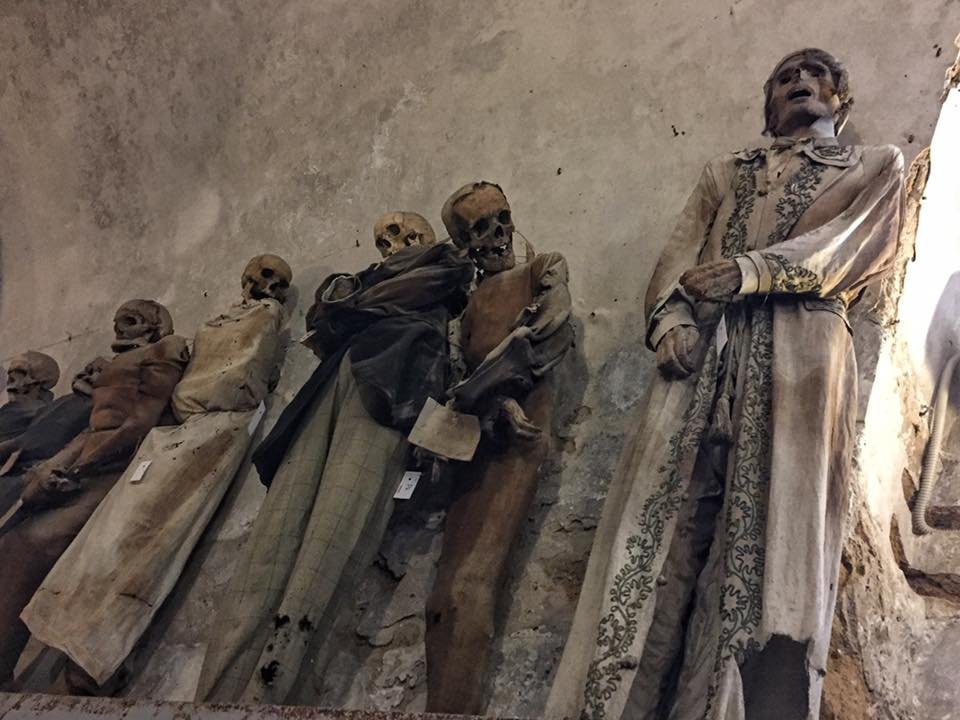
The Capuchin Crypt of Palermo, not far from the famous Corso Calatafimi, guards in its cellars a place that attracts thousands of visitors every year, a place where the living can meet the dead.
These are the famous catacombs of Palermo, built at the end of the 16th century and home to a total of around 8,000 bodies. The peculiarity lies in the perfect preservation of the bodies present, so much so that the mummies still have (after more than 400 years since embalming) skin, nails, mustaches and beards, as if they were simply sleeping.
But who were these people and why at the end of their life their body was “treated” and then exposed?
To answer this question, it must first be said that embalming was an expensive technique, and for this reason only wealthy families could afford to carry out such a treatment when a relative died.
For this reason, in these catacombs it is possible to find the Palermo citizens belonging to the most important social classes of the time, including various professionals, members of the military (some still wear their uniforms), bourgeois, merchants, young virgin women (who died before they could get married and who still wear their wedding dress), entire family groups and a small section dedicated to children.
The stories linked to the thousands of mummies present are really many and among these we cannot fail to mention Antonio Prestigiacomo, an incurable lover of women who lived in the 18th century, who left written his will to receive glass eyes immediately after death.
The reason? Simple, to be able to continue admiring women even after death! His gaze, even today, seems to actually fix those who pass in front of his body.
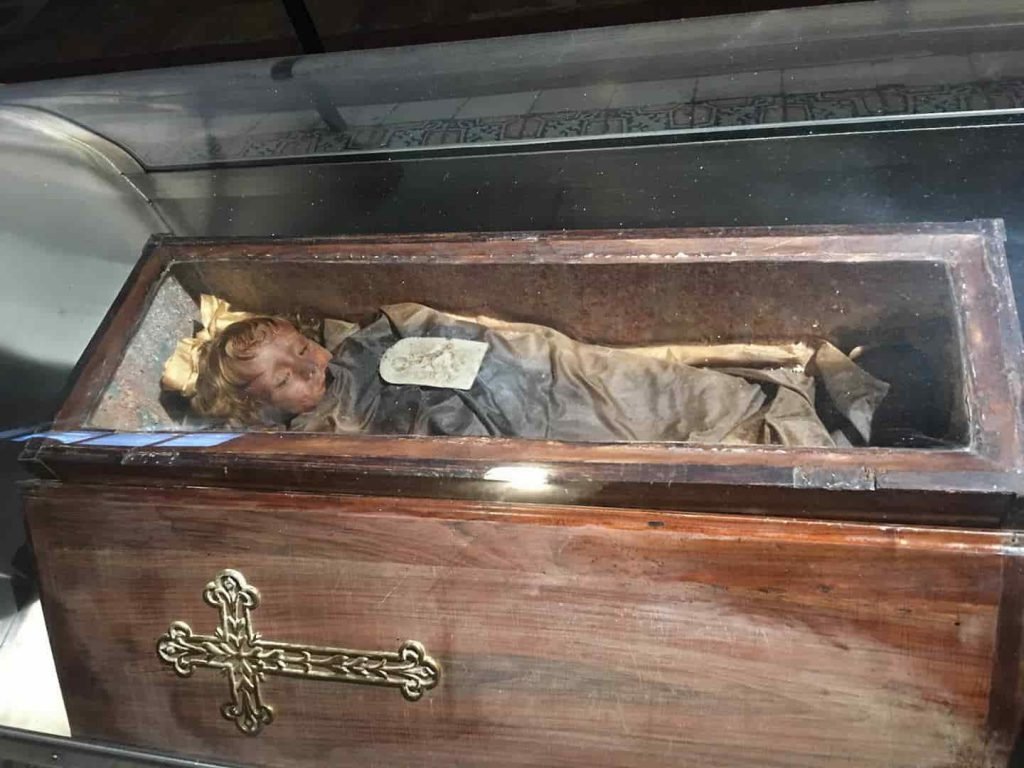
Even better known is the story of little Rosalia Lombardo, known as “The sleeping beauty of Palermo“, who died at the age of only two in 1920 and whose body has been incredibly preserved intact, thanks to the particular (and still unknown) method of embalming that Dr. Salafia applied to her.
The little girl is so well preserved that she seems to be simply sleeping, and she appears as a beautiful blonde girl with a yellow ribbon in her hair.
Inside the catacombs of Palermo, it is also possible to notice an ancient drain: the technique of the time in fact required the bodies to be left lying down for about a year to “drain”, before being deprived of their internal organs and washed with vinegar.
Finally, these were filled with straw and dressed in their own clothes, before being hung or laid down where they can still be admired today, offering visitors moments of reflection on the temporality of life.
The Teatro Massimo
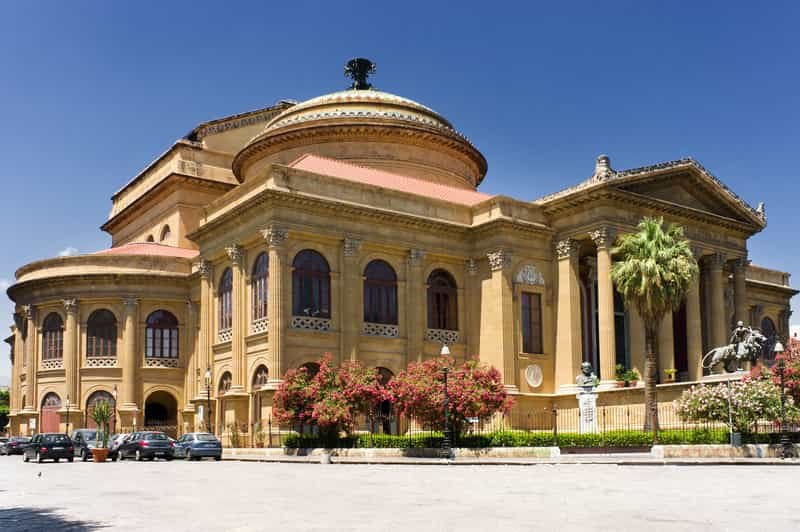
Set against the stunning backdrop of Piazza Giuseppe Verdi, which was revitalized in the late 19th century, the Teatro Massimo in Palermo stands as the largest theater in Italy and the third largest in Europe, boasting a sprawling 8,000 square meters of space.
This architectural marvel, brainchild of Giovanni Battista Filippo Basile, had its construction commenced in 1875 and was brought to life by his son, Ernesto Basile, in 1897.
Even from the outside, the Teatro Massimo exudes an undeniable visual impact, captivating visitors with its grandeur. It is no wonder that it is perhaps the most photographed monument in the city.
Following an extensive 20-year restoration project, the theater triumphantly reopened its doors in 1997. Its exterior features a grand staircase flanked by two bronze lions, while a massive hemispherical dome crowns its summit.
Stepping within, one is greeted by five tiers of ornate balconies and a gallery, bringing the total seating capacity to an impressive 3,200.
To make way for the theater’s construction, a church and an old cemetery, which was also the final resting place for several nuns, were demolished in 1875. Legend has it that the spirit of one of these nuns still roams the theater’s labyrinthine corridors, startling unsuspecting staff members.
The Teatro Politeama
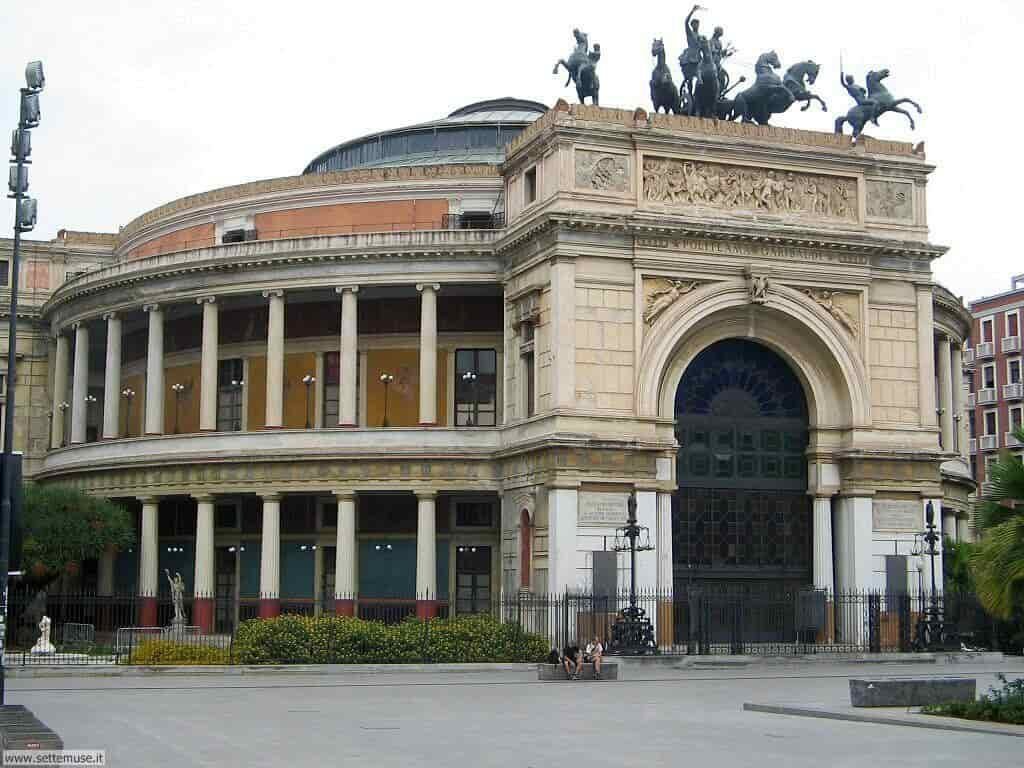
Enriching Piazza Ruggero Settimo, Palermo’s most renowned square (affectionately known as “Piazza Politeama” by locals), is the Teatro Politeama, a masterpiece conceived by architect Giuseppe Damiani Almeyda between 1867 and 1874.
The theater’s façade features a projecting central section adorned with a beautiful colonnade, while its rooftop boasts seven enormous bronze rearing horses, adding a touch of dramatic flair.
The upper floor of the theater houses the Civic Gallery of Modern Art “Empedocle Restivo,” showcasing a captivating collection of works that represent the panorama of contemporary Italian art, with a particular focus on Sicilian art, complementing the artistic treasures housed within Palazzo Abatellis.


